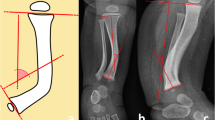Abstract
We report three infants with a poorly known form of congenital anterolateral angulation of the tibia with distinctive features seen on lateral roentgenograms. In these films the affected tibia appears to be divided into two segments, one proximal and the other distal, which taper as they approach each other at the site of the angulation, and end separately at the apex of the curve with an intervening radiolucent gap in the anterior tibial cortex. The two tibial segments are originally bridged and held firmly in that position by a well-defined triangular osseous structure located in the concavity of the tibial bow. It appears from the three cases reported in this paper and a few comparable cases in the literature that this form of tibial bowing is not prone to fracture followed by pseudoarthrosis and that it tends to improve (and resolve) spontaneously, with a resorption of the intramedullary bony structures at the apex of the curve resulting in the formation of a normal medullary cavity. A limb length discrepancy of varying degree is the main residual change of the anomaly.







Similar content being viewed by others
References
Badgley CE, O'Connor SJ, Kudner DF (1952) Congenital kyphoscoliotic tibia. J Bone Joint Surg (Am) 34:349–371, 494
Adamsbaum C, Kalifa G, Bonnet J-C (1991) Minor tibial duplication: a new cause of congenital bowing of the tibia. Pediatr Radiol 21:185–188
Tuncay IC, Johnston II CE, Birch JC (1994) Spontaneous resolution of congenital anterolateral bowing of the tibia. J Pediatr Orthop 14:599–602
Herring JA (2002) Tachdjian's pediatric orthopaedics, 3rd edn. WB Saunders, Philadelphia, p 882
Weaver KM, Henry GW, Rinker KA (1996) Unilateral duplication of the great toe with anterolateral tibial bowing. J Pediatr Orthop 16:73–77
Bressers MM, Castelein RM (2001) Anterolateral tibial bowing and duplication of the hallux: a rare but distinct entity with good prognosis. J Pediatr Orthop 10:153–157
Fawcett DW (1994) In: Bloom, Fawcett (eds) A textbook of histology, 12th edn. Chapman & Hall, New York, pp 194–233
Gilbert SF (1997) Developmental biology, 5th edn. Sinauer Associates, Sunderland, Mass., pp 349–388
Fawcett DW (1942) The amedullary bones of the Florida manatee (trichechus latirostris) Am J Anat 71:271–309
Potter EL (1961) Pathology of the fetus and the infant, 2nd edn. Year Book Medical Publishers, Chicago, pp 536–537
Author information
Authors and Affiliations
Corresponding author
Rights and permissions
About this article
Cite this article
Currarino, G., Herring, J.A., Johnston, C.E. et al. An unusual form of congenital anterolateral tibial angulation—the delta tibia. Ped Radiol 33, 346–353 (2003). https://doi.org/10.1007/s00247-002-0856-7
Received:
Accepted:
Published:
Issue Date:
DOI: https://doi.org/10.1007/s00247-002-0856-7




